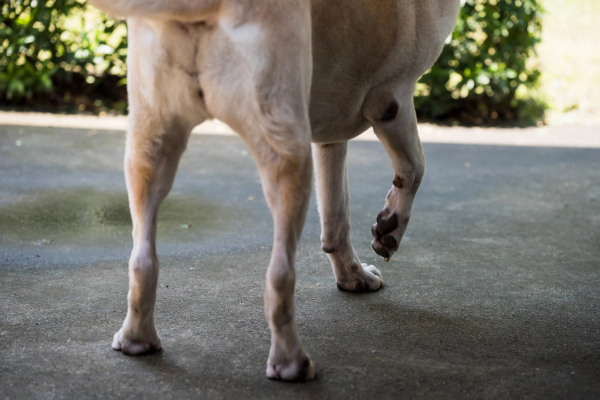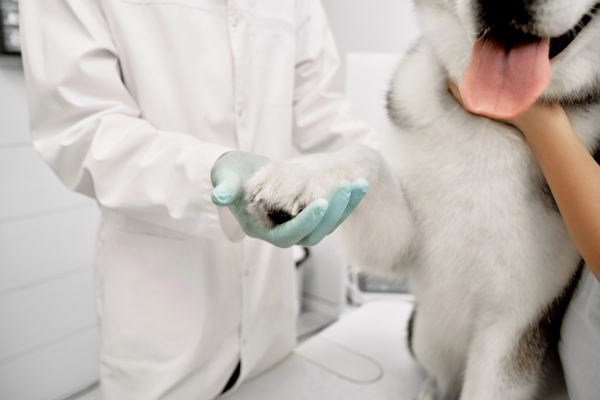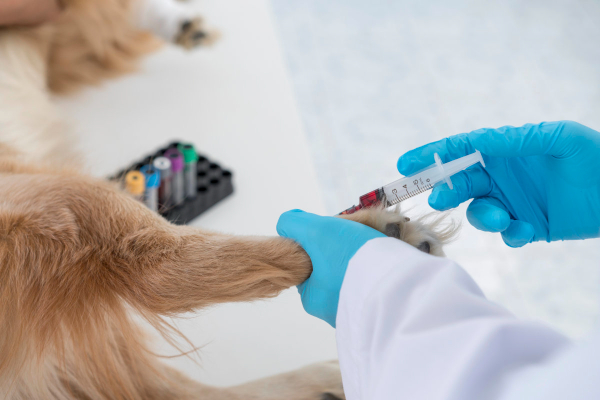IMPA in dogs (immune-mediated polyarthritis) occurs when the immune system attacks a dog’s joints, leading to painful swollen joints and lameness that seems to move from leg to leg. Integrative veterinarian Dr. Julie Buzby discusses the symptoms, causes, diagnosis, treatment, and prognosis for IMPA in dogs.

When you hear the word “arthritis,” you probably picture an old dog, maybe a grey-muzzled Golden Retriever, moving stiffly after a long nap. That’s the kind of arthritis we’re all familiar with—the slow, wear-and-tear kind that creeps up with age.
But not all arthritis is caused by aging joints. One specific form of arthritis, known as immune-mediated polyarthritis (IMPA), is an entirely different beast.
What is immune-mediated polyarthritis (IMPA) in dogs?
Immune-mediated polyarthritis (IMPA) is a condition in which a dog’s immune system mistakenly attacks his or her own joint tissue, causing pain, swelling, and lameness that can shift from leg to leg. Unlike arthritis caused by aging or injury, IMPA can come on suddenly and affect dogs of any age or breed.
When the immune system turns on its own joints, the end result is inflammation. This inflammation targets the synovial membranes, which line the inside of the joints and produce synovial fluid—the lubricant within the joints that supports smooth movement. When these membranes become inflamed, excess immune cells and fluid accumulate inside the joint spaces, leading to pain, swelling, and stiffness.
This process happens in multiple joints, hence “polyarthritis” in the name. The prefix “poly” means many and “arthritis” refers to the inflammation in the joints.
What are the symptoms of IMPA in dogs?
If your dog has IMPA, the signs might not always be obvious at first. Some dogs start out just seeming a little stiff or tired, while others show more dramatic symptoms. Here are some key things to watch for:
Shifting leg lameness
One of the most telling clinical signs of IMPA is that the limping (also known as lameness), doesn’t stay in just one leg. Dogs with IMPA may favor one limb one day and a different leg the next.

Swollen and/or painful joints
Unlike typical arthritis, which usually affects the same joint or joints over a long period of time, IMPA causes multiple joints to become inflamed, painful, and swollen at once. Due to the pain, dogs with IMPA may flinch or whimper when you touch their legs.
Reluctance to move around
Dogs with IMPA often seem reluctant to get up, climb stairs, or jump on or off furniture, even if they were active before.
Abnormal gait or pain when moving
Sometimes affected dogs have a tentative “walking on eggshells” gait, or they may cry out when they move in certain ways.
Fever
Since an overactive immune response causes IMPA, many dogs develop a fever. This fever may come and go, and in some dogs a fever may be the only outward sign of IMPA. Interestingly, in a study of 101 dogs with a fever of unknown origin, 20% of them ended up having IMPA.
Lethargy or depression
Normally energetic pups with IMPA might seem extra tired, uninterested in playtime, or just “off.” However, being a lethargic dog is a very non-specific sign.
Loss of appetite
Many dogs with IMPA don’t feel like eating. Inflammation from their overactive immune system, pain, or fever can all negatively impact interest in food.
Vomiting and diarrhea
Some dogs with IMPA experience gastrointestinal symptoms like nausea, vomiting, or diarrhea.
Neck or back pain
While IMPA primarily affects the leg joints, it can also cause inflammation in the vertebrae. Dogs with neck or back involvement may be hesitant to lower their head to eat or drink, avoid jumping, or cry out when touched in these areas.
Make an appointment with your vet if you see symptoms of IMPA
Because IMPA can look like other joint diseases—for example Lyme disease, orthopedic injuries, or even general aging—it is important to see your veterinarian if your dog is showing any of these signs. The sooner you can work together with your veterinarian to get to the bottom of your precious pup’s signs, the sooner he or she can be on the road to recovery.
How is IMPA classified?
Before discussing how the vet will know if your dog has IMPA, it helps to have a bit more background on the classifications, causes, and predisposing factors. IMPA in dogs can be classified in different ways, and the number of different classification systems can be confusing.

Erosive vs non-erosive IMPA
One way to categorize IMPA is based on whether it causes joint destruction. Non-erosive IMPA, the most common form, causes inflammation in the joints without damaging cartilage or bone. The much rarer form, erosive IMPA, leads to joint destruction over time and resembles rheumatoid arthritis in people.
Subclassification of the non-erosive form
A subclassification scheme for the non-erosive form of IMPA is based on the underlying cause:
- Type I: No identifiable cause or associated disease.
- Type II: Associated with infectious or inflammatory disease somewhere else in the body.
- Type III: Caused by inflammation secondary to gastrointestinal or liver disease.
- Type IV: Secondary to cancer at a site distant from the affected joints.
Primary vs secondary IMPA
An alternative way to classify IMPA is as primary or secondary. Primary IMPA (also called idiopathic IMPA) occurs when no underlying cause is found. This accounts for the majority of cases and encompasses Type I as classified above.
Secondary IMPA occurs when an external factor such as an infection or cancer triggers the immune system. In the classification scheme above, Types II through IV are all considered secondary.
Understanding these classifications helps guide diagnosis and treatment. Secondary IMPA may require finding and addressing the underlying trigger, while vets typically manage primary IMPA as an immune-mediated disorder.
What causes IMPA?
As discussed, there is no underlying trigger for primary IMPA. However, secondary IMPA has a variety of potential inciting causes, including:
Infections
When the immune system detects an infection, it produces antibodies (immune system proteins) to fight it off. Most of the time, things go as planned and the immune system prevails. But occasionally, the antibodies and the antigens (things the body sees as “foreign”) bind together and end up making their way into the joints, triggering inflammation and pain.
Some of the infections associated with IMPA in dogs include:
- Tick-borne diseases—Infections spread via tick bites such as Ehrlichiosis, Anaplasmosis, Rocky Mountain Spotted Fever, and Lyme disease have all been implicated as causes of joint inflammation. To make matters more complicated, tick-borne diseases in dogs often cause shifting leg lameness, fever, and swollen joints—symptoms that overlap with IMPA.
- Bacterial infections—Chronic infections, such as urinary tract infections (UTIs in dogs), pneumonia in dogs, prostatitis, or skin infections, can trigger an immune response that leads to joint inflammation.
- Viral and fungal infections—Less commonly, viral and fungal infections can contribute to immune system dysregulation and joint inflammation.

Cancers
Several types of cancer have been linked to secondary immune-mediated polyarthritis in dogs, including lymphoma in dogs, leukemia, and hemangiosarcoma in dogs. The systemic nature of these cancers leads to widespread immune system involvement, so it makes sense that they might lead to secondary immune-mediated diseases like IMPA.
Vaccines or medications
Vaccines and certain medications may theoretically induce IMPA, though researchers have not found a definitive link with vaccination. However, IMPA might be considered secondary to vaccination if signs develop within a month after receiving a vaccine.
IMPA, as with many other immune-mediated diseases, can rarely occur after taking certain medications. The medications most implicated are antibiotics like penicillins and cephalosporins.
Which dogs are more prone to IMPA?
While any dog can develop IMPA, genetics likely play a role in making some breeds more at risk. These include:
- Retrievers (Labrador Retrievers, Golden Retrievers)
- Spaniels (English Springer Spaniels, Cocker Spaniels)
- Collies and Shetland Sheepdogs
- German Shepherds
- American Eskimos
- Boxers
- Greyhounds
- Akitas
- Shar-Peis
Certain forms of IMPA also have specific breed tendencies. For example, steroid-responsive meningitis-arteritis (SRMA)—a condition that affects blood vessels in the spinal cord and can be seen in combination with IMPA —is more common in young, large-breed dogs like Boxers and Bernese Mountain Dogs. Erosive IMPA, the rarer form that leads to joint destruction and resembles rheumatoid arthritis in people, occurs more often in Greyhounds.
Of course, just because your dog is one of these breeds doesn’t mean he or she will develop IMPA. And regardless of your furry family member’s breed, if you notice joint pain, stiffness, or other worrisome signs, it’s always a good idea to check in with your veterinarian.
How will the vet diagnose IMPA in dogs?
Reaching a diagnosis of IMPA isn’t always straightforward. Since its symptoms can look like many other conditions, veterinarians have to rule out other causes before confirming IMPA. Here is what the diagnostic process might look like:
Step 1: Collect a history and conduct a thorough physical exam
Your veterinarian will start by asking about your dog’s symptoms, activity level, and any recent illnesses, vaccines, or medications. Plus he or she will check your dog’s vital signs, including his or her temperature. Then the vet will perform a thorough physical exam, paying close attention to joint swelling and pain, stiffness or reluctance to move, and any signs of illness beyond the joints—like weight loss or lethargy.
Step 2: Perform bloodwork and other lab tests

To look for infections or other signs of systemic illness, your veterinarian may recommend:
- A complete blood count (CBC) and chemistry panel—These routine blood tests for dogs look for signs of infection, inflammation, or organ dysfunction.
- Tick-borne disease testing—Since infections like Ehrlichia or Lyme disease can mimic IMPA, ruling them out is important. If testing for tick-borne disease is not possible, then your veterinarian may consider a trial of doxycycline, an antibiotic medication that treats many tick-borne infections.
- Urinalysis and urine culture—This testing can detect hidden urinary tract infections that could be triggering joint inflammation.
Step 3: Collect joint fluid for analysis—the gold standard test
The definitive way to diagnose IMPA is collecting joint fluid samples via arthrocentesis. Arthrocentesis involves inserting a small needle into the affected joints to withdraw joint fluid, which a veterinarian or veterinary pathologist will then analyze under a microscope.
Joint taps do require heavy sedation or anesthesia since the procedure is both briefly uncomfortable and requires the affected dog to remain very still. Since IMPA affects multiple joints, your veterinarian will usually sample between two and four joints. The carpi (wrist) and tarsi (ankle/hock) joints are common joints to sample.
In dogs with IMPA, the joint fluid typically shows high white blood cells in the fluid, which indicates inflammation. Plus, the joint fluid won’t contain any bacteria, which helps rule out a joint infection (septic arthritis).
In addition to looking at the joint fluid under the microscope, your vet may submit one or more of the samples for culture. This helps rule out septic arthritis by making sure no bacteria grow from the sampled joint fluid.
Step 4: Obtain necessary imaging (X-rays or ultrasound)
Radiographs (X-rays) of the joints help rule out underlying orthopedic disease or erosive arthritis (the rare form of IMPA that damages cartilage and bone). The vet may also recommend chest X-rays and/or an abdominal ultrasound to check for underlying infections, cancers, or systemic disease.
Remember, diagnosing IMPA is a process
As you can see, diagnosing IMPA takes careful detective work, but with a thorough approach, your veterinarian can usually pinpoint the cause. While joint taps may sound intimidating, they’re a crucial step in confirming IMPA and making sure your veterinarian is treating the right problem.
The sooner you and your veterinarian can obtain a diagnosis and start treatment, the sooner your furry family member can get back to doing what they love.
What is the treatment for IMPA?
Treatment for immune-mediated polyarthritis focuses on tamping down the overactive immune response, reducing joint inflammation, and relieving pain. However, the exact approach can vary widely depending on whether an underlying cause is found. While immunosuppressive therapy is the mainstay, identifying and addressing any underlying triggers is key to long-term success.
Treating the underlying cause (if there is one)
If the vet diagnoses the dog with secondary IMPA, the focus shifts to treating the root issue—such as an infection, cancer, or another systemic illness. However, continuing to give medications to reduce pain and inflammation in the meantime remains important.
Immunosuppressive medications
Since IMPA is driven by an overactive immune system, most dogs are started on immunosuppressive therapy. The mainstay of immunosuppressive therapy is the steroid prednisone for dogs. It rapidly reduces inflammation and suppresses the immune system’s attack on the joints. However, the downside to using steroids is that they often come with many side effects, such as increased thirst and urination, weight gain, muscle loss, and lethargy.
When their patients require more intense or long-term immunosuppressive therapy, many veterinarians consider adding on secondary immunosuppressive medications such as azathioprine, mycophenolate, leflunomide, or cyclosporine. The vet may also add these if steroids alone aren’t enough or if a dog needs a steroid-sparing approach due to serious steroid side effects.
Pain control
Even with steroids reducing the inflammation, many dogs need additional pain control to stay comfortable, especially in the first days to weeks of treatment. Vets often use gabapentin for dogs for chronic pain relief without interfering with the immune system.
Typically, non-steroidal anti-inflammatory drugs (NSAIDs) are great options for joint pain—but not in this case. Vets generally avoid them when using steroids because the combination of NSAIDs and steroids increases the risk of stomach ulcers in dogs.
Antibiotics for tick-bone diseases
Since infections like tick-borne diseases can trigger IMPA, some veterinarians prescribe the antibiotic doxycycline while waiting for test results or when additional infectious disease testing is not financially feasible.
What is the prognosis for dogs with IMPA?
The prognosis for dogs with immune-mediated polyarthritis is generally good, especially with early diagnosis and proper treatment. Most dogs respond well to immunosuppressive therapy and start improving within days to weeks.
However, relapses can occur, especially if medications are tapered too quickly or if an underlying trigger isn’t fully addressed. And some dogs experience flare-ups months or even years later, requiring adjustments in treatment.
Many dogs with primary (idiopathic) IMPA can eventually be weaned off medication. But some need lifelong low-dose immunosuppressive therapy to keep inflammation under control. The goal is always to use the lowest effective dose of medications to limit the side effects that commonly accompany these drugs.
Dogs with secondary IMPA often improve once the underlying disease is treated. And the vet can usually fully and permanently wean them off their medications.
All this is good news. But remember—regular veterinary check-ups and monitoring are key to making appropriate medication adjustments and catching relapses early. It is important to stay in close contact with your veterinarian during and after IMPA treatment.
Meet my patient with IMPA
I want to introduce you to a patient of mine, a sweet old chocolate Lab named Cooper. His owner brought him in, thinking his arthritis was just getting worse. But something didn’t add up. He wasn’t just stiff in the mornings; he was limping on different legs at different times, sometimes refusing to walk at all. My patient had a fever, seemed unusually tired, and even winced when I touched his joints.

This didn’t fit with the typical arthritis of old age. So I explained that I suspected this was something more complex—namely IMPA. After a thorough examination, joint taps, and X-rays, I confirmed that he did indeed have immune-mediated polyarthritis.
The good news? With the right treatment, Cooper got his spark back. After starting medication to control his overactive immune system and reduce his joint inflammation, he went from struggling to stand up to happily trotting after his favorite ball again.
His journey wasn’t instant—managing IMPA takes time, monitoring, and medication adjustments. But with dedication from his family and the right veterinary care, he found relief.
Be proactive in seeking veterinary care
If your dog is showing signs of unexplained joint pain, stiffness, or limping, trust your gut and talk to your veterinarian. Immune-mediated polyarthritis is a complex disease, but with early diagnosis and proper treatment, most dogs can go on to live happy, comfortable lives.
Has your dog been diagnosed with IMPA?
Please comment below

